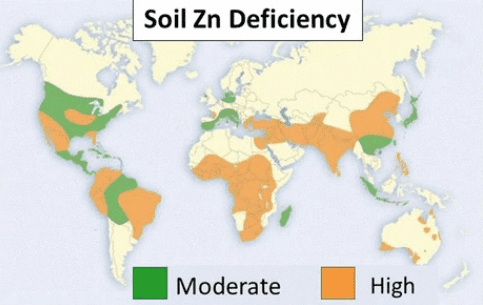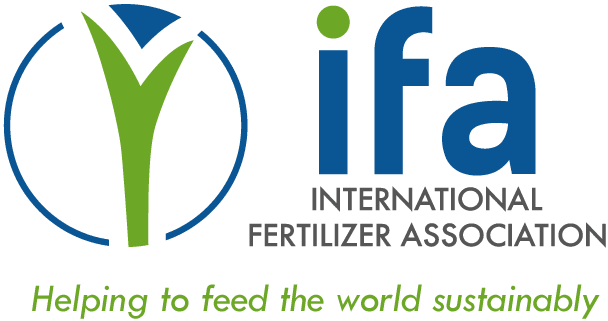Micronutrients

How fertilizers help to address the problems of hunger and malnutrition?
What are plant nutrients?
Plants need seventeen elements to grow:
- carbon (C), hydrogen (H), oxygen (O), which they obtain from the atmosphere and water;
- macronutrients: nitrogen (N), phosphorus (P), potassium (K), sulphur (S), magnesium (Mg), calcium (Ca);
- micronutrients: iron (Fe), manganese (Mn), zinc (Zn), copper (Cu), boron (B), molybdenum (Mo), chloride (Cl), nickel (Ni).
Some micronutrients essential to human health such as selenium (Se), iodine (I) and cobalt (Co) are not considered essential for plants, but can be taken up and accumulated by plants.
Macronutrients are found in plants at levels of 2 to 50 g/kg of dry matter or greater, while plant concentration of micronutrients range from 0.1 to 100 µg/kg. Plant growth is limited by the essential element that is furthest below its optimum: if a single essential plant nutrient is available in insufficient quantity, it affects plant growth and thus the yield. N, P and K are generally the most widely deficient elements but, nowadays, nutrients such as S, Zn and B are increasingly deficient in both soils and plants, becoming new limiting factors for crop yields throughout the world.
Mineral fertilizers provide essential macro- and micronutrients to plants, which in turn are passed on to people when consumed.
There is a direct correlation between micronutrient deficiencies in soils and plants and micronutrient deficiencies in humans.
Micronutrients are essential for human health: they contribute to prevent chronic diseases and stunting, they strengthen our immune and reproductive systems and enhance our physical and mental abilities (IPNI and IFA, 2012).
However, more than 2 billion people suffer from micronutrient malnutrition, sometimes referred to as “hidden hunger”. According to a report of the World Health Organization on the risk factors responsible for the development of illnesses and diseases, Zn and Fe deficiencies rank 5th and 6th among the 10 most important factors in low-income countries (Ten leading causes of illness and disease in low income countries, WHO, 2002).
Children are the most susceptible to micronutrient deficiencies: 1 of 3 children in the world are stunted; and the WHO estimates that, in 2017, over 6.3 million children under 15 years old and 5.4 million of them under 5, died as a result of deficiencies in essential nutrients, particularly micronutrients (WHO, 2019). The primary cause is diets poor in proteins and micronutrients, particularly iodine, Fe, vitamin A and Zn, or dietary changes associated to a lack of access to high-quality, micronutrient-rich foods. Stunting of children often begins before they are born, by poor quality of the diet of their mothers: micronutrient deficiencies can irreversibly affect development of children in the womb.
The potential risk of micronutrient deficiencies in the human population may be under-estimated considering that population surveys are done with human biomarkers, instead of surveys analyzing plant-available micronutrients in arable soils. For instance, since most of the Earth’s surface is iodine deficient, iodine deficiency disorders have the potential to affect a very large percentage of the world population.
Several agronomic problems have been linked to micronutrient deficiencies:
50% of world cereal soils are deficient in Zn, 30% of soils globally are deficient in Fe and most of the earth’s surface is iodine deficient (Fuge and Johnson 2015). Owing to often insufficient micronutrient fertilization, the steady growth of crop yields in recent decades has compounded the problem by progressively depleting soils of their micronutrient pools. The native soil properties, like alkalinity, can make micronutrients less available to plants, and some farming practices changing soil pH can aggravate or reduce the problem by making some micronutrients less or more available to plants.
Micronutrient deficiencies affect yields, either directly or indirectly by impairing physiological processes related to seed formation, synthesis and distribution of carbohydrates, biological N fixation and resistance to biotic and abiotic diseases. Some micronutrients, especially B, Mg and Cu are involved in cell wall stability and strength and thus increase plant resistance against pathogen penetration.
Micronutrient deficiencies can lead to the less efficient use of other essential plant nutrients potentially resulting in greater nitrogen losses to the environment and can lower crops’ water use efficiency.
Zinc, Mg and Fe are needed by the plants to detoxify strong oxidant compounds (called “reactive oxygen species”), which cause important cell damage under conditions such as drought, heat, salinity and extreme temperatures. Yield can be affected even if the crop is not showing overt deficiency symptoms, and micronutrient deficiency in crops often is not detected, unless farmers have access to a routine diagnostic service. By consequence, in many places, micronutrients are applied too late, or not at all, because farmers are not aware that micronutrient deficiency is limiting their yield and response to fertilizers.
It is important to consider global micronutrient balances to improve crop yield and quality and human health. Studies have also shown the importance of balanced nutrient feeding for improving livestock productivity (FAO, 2012).
Ensuring optimal supply of Zn and B in a well-managed fertilizer program, can have a measurable increase in crop production and return on the farmer’s investment, while the increased concentration of Zn in the plant will also be beneficial to human health.
There is a close correlation between micronutrient deficiencies in soils
and plants and micronutrient deficiencies in humans (Figure 1):






Figure 1: Geographical overlap of human Zn deficiency and soil Zn deficiency (Cakmak et al., 2017a, Plant and Soil, 411:1-4)


The cost of micronutrient deficiencies in humans.
Micronutrient deficiencies result in significant economic costs in developing countries: annual losses associated to them have been estimated to represent 5% of the GDP of certain countries, according to Gödecke et al (2018). A World Bank report published in 2014 further estimated that losses in India linked to vitamin and mineral deficiencies were as high as $12 billion in GDP. Economists estimate very high returns in terms of health, social and environmental development when micronutrient deficiencies are eliminated: according to a Report by the World Bank and the Asian Development Bank, eliminating micronutrient deficiencies in the world could enhance the intellectual capacity of populations by more than 10% and worker productivity by 30% to 70%. In addition, maternal deaths could be reduced by up to 50%
Fighting “Hidden Hunger” with agronomic biofortification.
People eating micronutrient-enriched crops or having diversified diets, including micronutrient-rich foods, are less likely to suffer from micronutrient deficiencies.
Mineral fertilizers that contain micronutrients can help address deficiencies in humans by increasing micronutrient density in the edible parts of plants. Reflecting synergies between protein and Fe and Zn accumulation in grain, fertilization with N (a key element in proteins) can positively impact Zn and Fe accumulation in wheat grain (Kutman et al. 2010, Aciksoz et al 2011).
One of the quickest and most cost-effective strategies to minimize the extent of micronutrient deficiencies in human populations is the enrichment (biofortification) of staple food crops with micronutrients (Welch et al 2013, Cakmak and Kutman, 2018; Cakmak et al 2017). Agronomic biofortification is defined as “the application of mineral micronutrient fertilizers to soils or plant leaves (foliar application) with the objective to increase the micronutrient content in the edible part of the crops”. Evidence suggests that agronomic biofortification with selected micronutrient fertilizers, such as Zn, Se and iodine is an effective and sustainable way to reduce deficiencies in populations around the world.
n a recently published paper using a simulated human digestive system it has been shown that iodine, Zn and Se in agronomically-biofortified wheat and rice are bioaccessible for use in the human body. Foods (such as bread and cookies) made from cereals biofortified with micronutrients through fertilizer strategy contained sufficiently high micronutrient levels, indicating an effective transfer of micronutrients from the field to the grain (Cakmak et al., 2017; Cakmak et al., 2020). A newly published human zinc absorption study conducted at ETH-Zurich demonstrated that wheat biofortified agronomically with Zinc has a significant role in dietary zinc absorption in humans and could be very helpful in counteracting the global burden of zinc deficiency (Signorell et al., 2019).
Agronomic biofortification has the advantage of getting a fast response with good bioavailability of the micronutrients applied, and it can be used in complementary manner with genetic fortification through plant breeding and food fortification (supplementing salt, flour or processed food with micronutrients).
An enabling environment is based on strategic cooperation with the fertilizer industry, who supplies the products, scientific organizations who assess the extent and impact of micronutrient deficiencies in soils, plants and human populations, governments, who stimulate the adoption of biofortification practices by farmers through economic incentives, subsidies and legislative mandates, and extension services, who contribute to assure technology and knowledge transfer.
Successes in agronomic biofortification.
Supplementing fertilizers with selenium (Se), Finland
Nordic countries are areas generally poor in Se. In 1984, Finland decided to counter its extremely low Se intake through supplementing fertilizers with Se. Almost all fertilizer used in Finland since then have contained Se and are currently required to contain 15 mg Se/kg. Supplementation of fertilizers with selenate has increased Se concentrations in all major food and feed crops and benefitted human and livestock health (Alfthan et al. 2014). While Finland has opted for a country-wide measure, the UK uses Se fertilization sporadically to improve human health and New Zealand supplements fertilizers with Se to improve livestock health.
Using Zn-enriched fertilizers.
Half of the world’s agricultural soils are deficient in Zn and one third of the world population is zinc-deficient (Alloway, 2008). The use of Zn-enriched fertilizer (for instance Zn-coated urea or Zn-enriched NPK) in Turkey, Australia, South Africa or India has resulted in significant increases in yields and in zinc concentrations in rice and wheat (IFA and IPNI, 2012). The best performance to increase zinc density in grain is obtained through foliar applications (Cakmak and Kutman, 2018).
Increasing iodine density in cereals.
A recent study has shown that: “agronomic biofortification using a foliar-applied fertilizer containing iodine, alone or in combination with Se and Zn, is effective in improving grain iodine concentration.” The study also examined potential iodine losses during the preparation of foodstuffs with the enriched grains and found that iodine levels had lowered but remained significantly higher than foodstuffs prepared with non-enriched grains (Cakmak et al, 2020).
HarvestZinc.
The international project HarvestZinc (harvestzinc.org) has demonstrated that simultaneous foliar applications of Zn, iodine, Se and Fe in the same cocktail solution resulted in significant increases in Zn, iodine and Se concentration and modest ones in Fe in grains of different wheat cultivars under various agro-ecological conditions without grain yield tradeoff (Zou et al, 2019).
References.
Aciksoz, S.B., Yazici, A., Ozturk, L. and Cakmak, I. 2011: Biofortification of wheat with iron through soil and foliar application of nitrogen and iron fertilizers. Plant Soil. 349: 215-225.
Alfthan, G., Eurola, M., Ekholm, P., Venäläinen, E.R., Root, T., Korkalainen, K., Hartikainen, H., Salminen, P., Hietaniemi, V., Aspila, P. and Aro, A. 2014. Effects of nationwide addition of selenium to fertilizers on foods, and animal and human health in Finland. From deficiency to optimal selenium status of the population. Journal of Trace Elements in Medicine and Biology. 31. 10.1016/j.jtemb.2014.04.009.
Alloway, B.J. 2008. Zinc in Soils and Crop Nutrition
Andersson, M., Karumbunathan, V. and Zimmermann, M.B. 2012: Global iodine status in 2011 and trends over the past decade. J. Nutr .142:744–750.
Fuge, R., Johnson, C.C. 2015. Iodine and human health, the role of environmental geochemistry and diet, a review. Applied Geochemistry 63: 282-302. https://doi.org/10.1016/j. apgeochem.2015.09.013.
Cakmak, I., Prom-u-thai,C., Guilherme, R. G., Rashid, A., Hora, K.H., Yazici, A., Savasli, E., Kalayci, M., Tutus, Y., Phuphong, P., Rizwan, M., Martins, F.A.D., Dinali, G.S. and Ozturk, L. 2017. Iodine biofortification of wheat, rice and maize through fertilizer strategy. Plant and Soil. 418: 319–335.
Cakmak, I., Marzorati, M., Van den Abbeele, P., Hora, K., Holwerda, H.T., H., Atilla Yazici, M., Savasli E.; Neri, J., and Du Laing, G. Fate and Bioaccessibility of Iodine in Food Prepared from Agronomically Biofortified Wheat and Rice and Impact of Cofertilization with Zinc and Selenium. Journal of Agricultural and Food Chemistry 2020 68 (6), 1525-1535 DOI: 10.1021/acs. jafc.9b05912
Cakmak, I. and Kutman, U.B. 2018: Agronomic biofortification of cereals with zinc: a review. Eur. J. Soil Sci. 69
Gödecke, T.; Stein, A.J. and Qaim, M. 2018: The global burden of chronic and hidden hunger: trends and determinants. Glob. Food Sec. 17: 21-29.
IPNI, IFA. 2012. Fertilizing Crops to Improve Human Health: A Scientific Review. First edition, IPNI, Norcross, GA, USA; IFA, Paris, France, October 2012
Kutman, U.B., Yildiz, B., Ozturk, L. and Cakmak, I. 2010: Biofortification of durum wheat with zinc through soil and foliar applications of nitrogen. Cereal Chem. 87: 1-9.
Lyons, G. 2018: Biofortification of cereals with foliar selenium and iodine could reduce hypothyroidism. Front. Plant Sci. 2018, 9, 730.
Welch, R.M., Graham, R.D., Cakmak, I. 2013. Linking agricultural production practices to improving human nutrition and health. Expert Paper Written for ICN2 Second International Conference on Nutrition Preparatory Technical Meeting, 13-15 November, 2013, Rome, Italy. http://www.fao.org/3/a-as574e.pdf. World Bank. 2014. Press Release “India has potential to dramatically reduce stunting in children, says new
World Bank report”. Available at: https://www.worldbank.org/en/news/
World Health Organization. 2002. The World Health Report: Reducing risks, promoting healthy life.
WHO Newsroom. 19 September 2019. Factsheet “Children: reducing mortality” Available at: https://www.who.int/
Zou, C.Q., Du, Y.F., Rashid, A., Ram, H., Savasli, E., Pieterse, P.J., Ortiz-Monasterio, I., Yazici, A., Kaur, C., Mahmood, K., Singh, S., Le Roux, M.R., Kuang, W., Onder, O., Kalayci, M. and Cakmak, I. 2019. Simultaneous biofortification of wheat with zinc, iodine, selenium and Iron through foliar treatment of a micronutrient cocktail in six countries. Journal of Agricultural and Food Chemistry 2019 67 (29), 8096-8106. doi: 10.1021/acs.jafc.9b01829.
